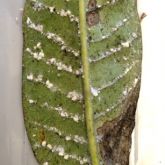Papaya mealybug
Alert
Be on the lookout for papaya mealybug. It has been found in:
- South East Queensland
- Townsville.
Report sightings outside these locations
- Report online
- Call Biosecurity Queensland on 13 25 23

Papaya mealybug infestation on frangipani leaf underside
© Queensland Government

Papaya mealybug crawlers (nymphs)
© Queensland Government

Thick white wax secreted by papaya mealybug on papaya plant
© Queensland Government
Papaya mealybug (Paracoccus marginatus) is an invasive pest that can spread rapidly. It forms large infestations on leaves, fruit and stems of host plants such as papaya, frangipani and hibiscus.
In Australia, the pest was first detected in the Darwin area of the Northern Territory in July 2023. It was detected in South East Queensland and Townsville in 2024.
Papaya mealybug can be a threat to commercial papaya production, as well as backyard papaya trees, frangipani and hibiscus.
Papaya mealybug and the fruit they have infested pose no threat to humans.
Description
Insect
- Oval shaped
- 2.0–3.5mm long
- Yellow body covered in white wax with a fringe of short filaments
- Round yellow eggs laid inside an egg sac
Plant damage
- Leaf chlorosis, deformation or crinkling
- Premature aging of leaves
- Flowers and fruit may be underdeveloped or may drop under severe infestation
- Sooty mould
- Thick white, sticky waxy coating on leaves, stem and fruit
May be confused with
Papaya mealybug may be confused with other mealybugs. Identification of papaya mealybug can only be done by a specialist.
Distribution
Papaya mealybug is thought to have originated in Central America. There is widespread distribution throughout the tropical regions of Asia, North, Central and South America, Africa and the Pacific.
In Australia, papaya mealybug is only known to occur in:
- Darwin, Northern Territory
- Townsville, Queensland
- South East Queensland.
Hosts
Papaya mealybug has a known host range of over 200 plants.
Preferred hosts include:
- papaya
- frangipani
- hibiscus.
Other hosts include:
- avocado
- capsicum
- cherry
- cotton
- eggplant
- grapefruit
- guava
- jatropha
- mango
- pea
- pomegranate
- sweet potato
- teak
- tomato.
Life cycle
- 100–600 eggs are laid.
- Once hatched, first instar crawlers (nymphs) start feeding on sap from plant tissue.
- Females undergo 4 instars before moulting into adults.
- Males undergo 2 instars, then pre pupa and pupa, and then emerge as winged adults.
- There may be up to 5 generations per year depending on climatic conditions.
Impacts
Papaya mealybug is a pest of a wide range of host plants. It may cause severe damage to crops, reduce crop yield, and disrupt domestic and international market access.
Backyard growers of papaya can also be affected by papaya mealybug infestations.
How it is spread
The biggest risk of spread of papaya mealybug is through the movement of infested plant material, soil or fruit.
Papaya mealybug is most easily spread when they are nymphs, attached to moving plants.
Papaya mealybug nymphs have a limited range of natural dispersal to neighbouring plants. Strong winds may increase the range of dispersal.
Monitoring and action
If you have papaya, frangipani and hibiscus trees, inspect them for papaya mealybugs.
If you suspect the presence of papaya mealybug in Far North or Central Queensland:
- report online
- call Biosecurity Queensland on 13 25 23.
Prevention
Control
- Purchase healthy plants from accredited nurseries. Implement cultural control practices to prevent spread, maintain good garden hygiene and do not move infested plants to new locations.
- For early infestation, remove mealybugs and the waxy coating they produce from the fruit, leaves and stems with a cleansing wipe. Dispose of the mealybugs and wipe in a sealed bag in the general waste—do not compost or dispose of in garden waste.
- Biological control agents (such as Cryptolaemus ladybird, lacewing or hover fly) are suitable control methods—Cryptolaemus ladybird can be sourced from accredited suppliers.
- Control ant populations that forage around mealybugs—ants feed on mealybug honey dew and can deter natural enemies.
- Spray oil or soap-based pesticides—always follow label instructions when applying pesticides.